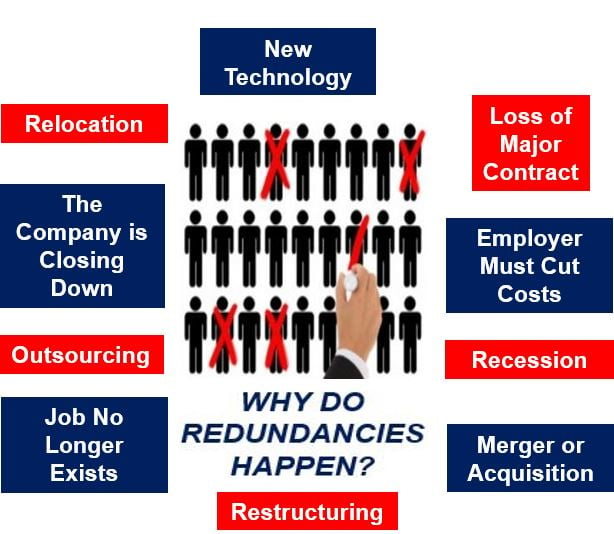How to Deal With Redundancy Pay If Company Goes Bust: Key Information for UK Employees
How to Deal With Redundancy Pay If Company Goes Bust: Key Information for UK Employees
Blog Article
Checking Out the Interplay In Between Company Redundancy and Business Versatility for Future Development
In the vibrant landscape of today's company world, the complex partnership between company redundancy and business flexibility arises as an essential element for continual development and success. Firms typically encounter the obstacle of striking a fragile equilibrium in between maintaining a level of redundancy to reduce dangers and promoting versatility to react quickly to the ever-evolving market needs.
Relevance of Firm Redundancy
Firm redundancy is a crucial element that enhances organizational resilience and mitigates operational risks. By incorporating redundancy measures within the organizational framework, firms can much better hold up against unexpected interruptions and fluctuations in business environment. Redundancy acts as a tactical buffer, allowing companies to adapt and respond efficiently to unforeseen challenges without jeopardizing necessary procedures.
One trick facet of the relevance of firm redundancy is its role in making sure continuity during times of dilemma. When faced with sudden adjustments or emergency situations, repetitive systems, sources, or employees can tip in to keep crucial functions and protect against prevalent disturbances. This connection not just safeguards the company's reputation and client count on yet likewise reduces economic losses and operational downtime.

Strategies for Organizational Adaptability

One more essential approach is buying technology and facilities that can sustain adaptability and scalability. Implementing digital devices, automation, and information analytics can improve procedures, improve performance, and offer useful understandings for educated decision-making. Moreover, producing adaptable business frameworks that enable for fast adjustments to market dynamics and customer requirements is important for staying competitive in a quickly advancing environment. By proactively identifying prospective interruptions and possibilities, organizations can proactively flourish and adapt in an ever-changing business landscape.
Harmonizing Redundancy and Versatility
Achieving an unified stability in between operational redundancy and business flexibility is critical in navigating the intricacies of a dynamic service environment. Striking the appropriate equilibrium in between redundancy and adaptability is a fragile process this article that requires a deep understanding of the company's goals, industry dynamics, and danger resistance.
To achieve this balance, companies need to conduct regular assessments of their operations to identify areas where redundancy is necessary for threat reduction and where flexibility can drive innovation and growth. Implementing flexible frameworks, cultivating a society of constant discovering and enhancement, and motivating open communication across all degrees of the company are crucial methods to balance redundancy and versatility successfully. By lining up these two vital aspects, companies can position themselves for sustainable growth and success in an ever-changing business landscape.
Study on Adaptation Success
In checking out circumstances of successful organizational adjustment, it comes to be evident that the interaction in between operational redundancy and versatility is a specifying element in forming resistant businesses. A DVD rental solution, Netflix showed amazing versatility by transitioning right into a streaming platform when digitalization interrupted the industry. These instance research studies emphasize the significance of functional redundancy coupled with organizational flexibility in cultivating long-term growth and competition.
Structure Durability for Future Development
Building strength read this for future growth needs a strategic placement of operational procedures with market characteristics and emerging trends. Companies need to adjust to transforming atmospheres by promoting a society of flexibility, advancement, and continuous improvement. Durability includes not just bouncing back from problems but also proactively planning for future difficulties. One essential aspect of structure durability is buying durable danger management approaches to alleviate potential disturbances. This includes scenario preparation, diversifying supply chains, and creating contingency plans for different contingencies (who pays redundancy money).
Furthermore, fostering solid relationships with stakeholders, such as clients, employees, vendors, and the area, is necessary for weathering uncertainties and keeping trust and support throughout turbulent times. Efficient interaction and transparency play a crucial role in building durability, as they aid assist in and straighten expectations partnership in browsing uncertainties.
Additionally, companies require to prioritize knowing and advancement campaigns to upskill employees and furnish them with the essential tools to adjust to transforming circumstances. By purchasing their labor force, firms can enhance their adaptability and agility, inevitably reinforcing their resilience for sustainable future growth.
Final Thought

In the vibrant landscape of today's company globe, the intricate connection in between company redundancy and organizational flexibility emerges as a critical element for continual development useful reference and success. Companies commonly encounter the challenge of striking a fragile equilibrium in between maintaining a level of redundancy to minimize risks and promoting versatility to react swiftly to the ever-evolving market demands.To attain this balance, companies need to perform normal assessments of their operations to determine locations where redundancy is essential for risk mitigation and where versatility can drive advancement and development.In verdict, the interplay between company redundancy and organizational versatility is critical for future growth. Building durability with a mix of redundancy and flexibility will certainly ensure that companies are prepared for the challenges of the future.
Report this page